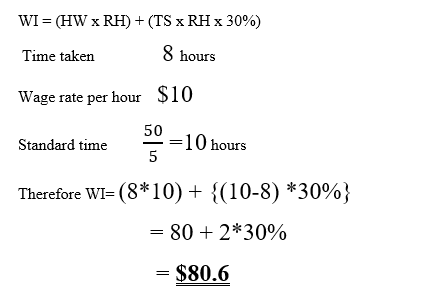Halsey-Weir Plan: Definition; Characteristics; Formula; Advantages And Disadvantages
1.1 Definition:
Halsey-Weir Plan is a scheme or employee rewarding methodology which is pegged on rewarding of the employees with some bonus for finishing the task before the time limit. Generally, the bonus set aside is a percentage of the wages gotten by the employee.
NB: that Halsey-Weir Plan is a modified method for Halsey Premium Plan where the latter advocates that an employee to be paid a bonus of 50% for the time saved plus the salary for the actual time spent on the job. While for the Halsey-Weir Plan, an employee is paid a bonus of 30% for the time saved plus the salary for the actual time spent on the job.
1.2 Characteristics of Halsey-Weir Plan
- Halsey-Weir Plan sets a standard time in advance to lay a roadmap to the employees as they engage, they are already aware of the expectations thereof.
- Halsey-Weir Plan is dominated by a guaranteed income for the employees. So, the worker gets the guaranteed income irrespective of whether he meets the firm performance target or not.
- Halsey-Weir Plan is characterized by 30% bonus structure which is pegged on the time saved by the employee.
1.3 Formula for Halsey-Weir Plan or Method
So, how is the total wage income under Halsey-Weir Plan computed?
Wage income= (Hours worked x Rate per hour) + (Time saved x Rate per hour x 30%)
OR
WI = (HW x RH) + (TS x RH x 30%)
EXAMPLE
Roosevelt works with XYZ manufacturing firm which deals with production of three types of products, namely; X, Y and Z. Roosevelt has specialized in production of product Y and the following is a production schedule for the 8 hours worked per day.
XYZ manufacturing co. ltd has the following wage rate terms and condition for the employees it has engaged in production
Time rate of wages is $10 per hour
Standard output 5 units per hour
Actual hours worked 8 hours
Actual output 50 units.
REQUIRED
Determine the total wages paid to Roosevelt
Solution

1.4 Advantages of using Halsey-Weir Plan to Compute Labor Cost
- Halsey-Weir Plan is a simplified approach for calculating the labor cost.
- Halsey-Weir Plan assures employees of some income at the end of the day.This method incorporates some pre-determined income for the employee and this is very much encouraging to the workers for they are assured of some income at the end of it all.
- Halsey-Weir Plan reduces the overall cost of production for the organization.The 30% component in the formula of Halsey-Weir Plan implies that the firm is saving 70% of the production cost. So, the paying of employees a 30% of the saved time, at the same time the 70% not paid to the workers is a cost saving element for there was additional output which was associated to that particular employee who was being paid the bonus.
- Halsey-Weir Plan is an employee motivating tool.The 30% bonus element is good enough to propel the employee to work more harder even when he or she had an history of low performance.
- Less labor turnover.Halsey-Weir Plan of additional 30% of the saved time is a way of creating a feeling of security among workers as the plan assures a minimum hourly rate or guaranteed wage. This makes the workers concentrate on production other than looking for greener pastures.
- Not punitive.Halsey-Weir Plan aims at rewarding the efficient workers by way of payment of bonus, but that does not mean punishing the less active employees. Instead, they are not penalized. They are spared.
1.5 Disadvantages of using Halsey-Weir Plan to Compute Labor Cost
- Compromise to quality of the work done.Many employees under Halsey-Weir Plan find themselves being ignorant of the quality of the output associated to them as long as quantity is taking the lead. This is disadvantageous to the organization when it comes to matters of reputation of its products in the market.
- Management faces sharp criticism from the employees.The Halsey-Weir Plan provokes the Workers for paying them 30% of the saved time which means the balance (70% retained by the firm) is not termed as fair by the employees who have worked hard to achieve these results.
- Cumbersome to set the standard time.Halsey-Weir Plan faces controversies and hot debate from the employees for there is no universally accepted time rate set by both parties. This creates a bad relationship between the workers and their employers across most organizations.
- Lack of optimal utilization of firm resources.The Halsey-Weir Plan is known for wastage of raw materials due to workers focusing on more and more output. For they always avoid any process which takes their time meant for more output. This results to carelessness in handling the resources of the firm such as raw materials.